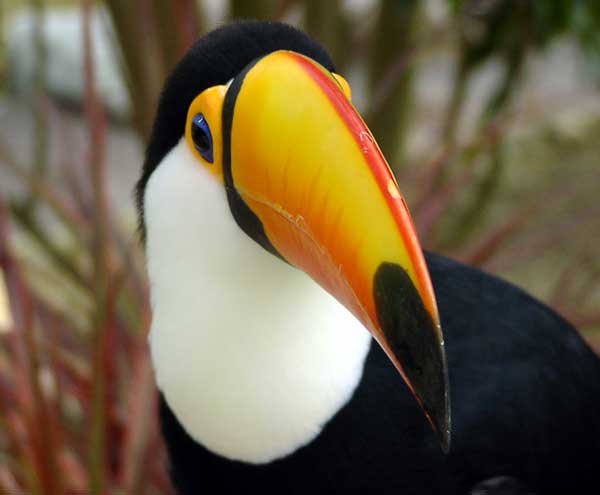Toco Toucan (Ramphastos toco) - Wiki Toco Toucan
From Wikipedia, the free encyclopedia
Order: Piciformes
Family: Ramphastidae
[Photo] Toco Toucan (Ramphastos toco). Photo by Daph Chloe (http://commons.wikimedia.org/wiki/User:Daph_Chloe).
The Toco Toucan (Ramphastos toco) is the largest and arguably best known species in the toucan family. It is found in semi-open habitats throughout a large part of central and eastern South America. It is a common attraction in zoos.
Description
The Toco Toucan has a striking plumage with a mainly black body, a white throat, chest and uppertail-coverts, and red undertail-coverts. The iris is blue and surrounded by a ring of bare, orange skin. The most noticeable feature, however, is its huge bill, which is yellow-orange, tending to deeper reddish-orange on its lower sections and culmen, and with a black base and large spot on the tip. It looks heavy, but as in other toucans it is relatively light because the inside largely is hollow. The tongue is nearly as long as the bill and very flat. With a total length of 55-65 cm (22-26 in), incl. a bill that measures almost 20 cm (8 in), and a weight of 500-850 g (17.5-30 oz), it is the largest species of toucan. Males are larger than females, but otherwise the sexes are alike. Juveniles are duller and shorter-billed than adults. Its voice consists of a deep, coarse croaking, often repeated every few seconds. Also has a rattling call and will bill-clack.
Distribution
It occurs in northern and eastern Bolivia, extreme south-eastern Peru, northern Argentina, eastern and central Paraguay, eastern and southern Brazil (excluding southern Rio Grande do Sul, the dry regions dominated by Caatinga vegetation and coastal regions between Cear?? and Rio de Janeiro). Other disjunct populations occur along the lower Amazon River (Ilha de Marajo east approximately to the Madeira River), far northern Brazil in Roraima, and coastal regions of the Guianas. It only penetrates the Amazon in relatively open areas (e.g. along river corridors). It is resident, but local movements may occur.
Habitat & Status
It is, unlike the other members of the genus Ramphastos, essentially a non-forest species. It can be found in a wide range of semi-open habitats such as woodland, savanna and other open habitats with scattered trees, Cerrado, plantations, forest-edge and even wooded gardens. It is mainly a species of lowlands, but occurs up to 1750 m (5750 ft) near the Andes in Bolivia. Due to its preference for open habitats it is likely to benefit from the widespread deforestation in tropical South America. It has a large range and except in the outer regions of its range, it typically is fairly common. It is therefore considered to be of Least Concern by BirdLife International. It is easily seen in the Pantanal.
Behavior
The Toco Toucan eats mainly fruit (e.g. figs and Passiflora edulis) using its bill to pluck them from trees, but also insects, and nestlings and eggs of birds. Has been known to capture and eat small adult birds in captivity. The long bill is useful for reaching things that otherwise would be out-of-reach. It is also used to skin fruit and scare off predators. It is typically seen in pairs or small family-groups. In flight it alternates between a burst of rapid flaps with the relatively short, rounded wings and gliding. Nesting is seasonal, but timing differs between regions. The nest is typically placed high in a tree and consists of a cavity, at least part of which is excavated by the parent birds themselves. It has also been recorded nesting in holes in earth-banks and terrestrial termite-nests. Their reproduction cycle is annual. The female usually lays two to four eggs a few days after mating. The eggs are incubated by both sexes and hatch after 17-18 days. These birds are very protective of themselves and of their babies.
Aviculture
The Toco Toucans can become pets if taken from the nest and hand reared as babies. Their requirements are specific but basic, and must be strictly adhered to. Requirements include items such as spacious cages to move about because of their active nature, and toys in their cage to provide mental stimulation. They have an almost exclusive frugivorous (fruit) diet; with that diet comes a sensitivity to hemochromatosis (iron storage disease) which can make them difficult for the novice keeper to maintain. When provided with these things they make wonderful affectionate pets and can be quite hardy in a captive environment. The record for captive longevity is 26 years.
There is an ongoing population management plan that will help to attain the decreasing captive population of the Toco Toucan. This will be the second management plan that is occurring since 2001. When the population falls below 90%, reproduction will take effect by decreased birth weights, smaller litters and greater mortality rates. The existing captive population structures permits the changing of gene diversity by ninety percent for one year. This test will allow the captive population to have an increasing growth rate and overall improve the species by allowing the life span to be longer.
http://en.wikipedia.org/wiki/Toco_Toucan
| The text in this page is based on the copyrighted Wikipedia article shown in above URL. It is used under the GNU Free Documentation License. You may redistribute it, verbatim or modified, providing that you comply with the terms of the GFDL. |
